A rough ride on your old car can be caused by a number of factors. Here are some steps you can take to diagnose and possibly resolve the problem:
Check Tire Condition:
Tire Pressure: Make sure all tires are inflated to the recommended pressure.
Tread Wear: Check for uneven wear or bald spots. Replace tires if necessary.
Alignment: Misalignment can cause uneven tire wear and a rough ride. Check alignment.
Check suspension components:
Shocks/Struts: Worn shocks or struts can cause a bumpy ride. Check for leaks or damage and consider replacing if worn.
Springs: Check the coil springs for sagging or damage. Replacing them can improve ride quality.
Check whether parts are loose or worn:
Look for any loose or worn parts in the suspension system, such as bushings, control arms or ball joints. Replace any damaged parts.
Check the chassis:
Check the chassis for rust or damage that could affect ride quality. Make repairs as needed.
Check wheel bearings:
Worn wheel bearings can cause noise and a rough ride. If you notice any grinding or unusual noises, get them checked out.
Brake system:
Make sure brake components are in good condition. Worn brake pads or twisted rotors can cause vibration.
Check engine and transmission problems:
Sometimes, a rough ride can be related to an engine or transmission problem. Make sure the engine runs smoothly and the transmission shifts correctly.
Consider upgrading components:
If the car is older, consider upgrading to performance shocks or struts for a smoother ride.
Professional inspection:
If you are unsure or unable to diagnose the problem, consider taking your car to a mechanic for a thorough inspection.
Fixing these issues can help improve the ride quality of your older car.
Post time: Nov-16-2024

